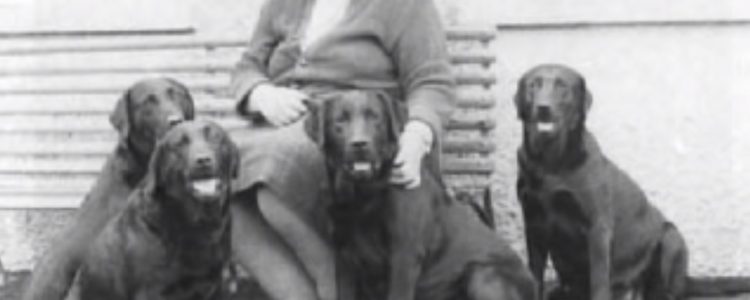
Mary Roslin Williams of Mansergh Gundogs
She bred Labs, she hunted over Labs, she competed with Labs and she taught about Labs. She had seven generations of champions, and 15 or so dogs who won field trial awards.
In the early days, she lived in Mansergh Parish, just south of the Lake District in England.
Mary Roslin Williams taught from practical experience and common sense.
Although she's no longer with us, she left behind knowledge that she shared. Read a bit and then take a half hour to listen.
The start of the show/field divide
"I started this book by pointing out that at any one time there are about twenty top breeders who can and do stay at the top for many years, but when I come to the breeders who can show their dogs as Championship show-prize winners and also run them in Trials as Trial dogs, accepted as such by the Trial people and not called 'Bl---y show dogs' as is their wont, then I find it hard to name twenty kennels that can do this in the last forty years.
"Before the last War there were plenty of strains capable of doing this, indeed it was more or less the norm. The whole atmosphere of Labrador breeding was different, with such people as Lorna, Countess Howe seeing to it that the show Labrador remained a working dog. ... The dogs were good-looking on proper Labrador lines, they were thoroughly experienced shooting dogs and cut out their own work with the minimum of help from their handlers, although always ready to take the hint when they were stuck. The good work on the day was put in by the dogs and not the handlers, and while Lady Howe was alive this happy state of affairs, when Trials were fun and you and your dogs welcome, remained until the sad day she died, when we immediately feared and experienced the Great Divide, into entirely show bloodlines and entirely Field Trial, poles apart."
A water dog
"It's a great sadness to me, that when they named the Labrador they didn't call it the 'Labrador Water Retriever' ... because we forget that the dog is a water dog.
"It's job was water work. It's job still is water work and we've adopted it and adapted it for different works. But in many countries that we sell our puppies to ... they expect that dog to work in water. Very largely. And if you sell a dog to Canada it will be working in water in terrible frost. In cold water. Hours at a time. We ought to remember that, both when we breed and when we judge....
Defining type
"The next thing is the Labrador is a Labrador. Now here is a difficult thing because this is type and however much you have a standard, one thing it cannot describe is type. You've got to have type in your head. ... Perhaps type varies a little from country to country. ...
"My criterion for Labrador type is a very simple one. It must look like a Labrador. It mustn't look like a Foxhound. It mustn't look like a Pointer ... It mustn't look like a Golden Retriever. ...
Pointer
"You get unmanageability. It's an outward bound dog. It's horizon is 300 yards away. It's hind legs make it gallop because they can't help galloping. It's head is held too high. It's elbow is angulated for a high head carriage and you don't want it in a Labrador. We used to get it. And besides that we've always got a very, very short coat."
Foxhound
"The Foxhounds came in deliberately. ... And what came with it? Arrogance... When he went to judgment, instead of looking at you like a Labrador should - they did that (turned head away) - with the proudest, most arrogant expression. Now that got into the breed very badly, so that we had championship show judges writing in their critique ... correct arrogant expression.... It's absolutely wrong.
"And the other terrible fault we got in there was that they were very fastidious. ... They did not like opening their mouths in dirty water. I can't blame them. I don't like opening my mouth in dirty water. And I don't intend to which is why I have a dog..."
Flatcoat
"Now the next thing that happened was that somebody realized this and they quietly moved in a Flatcoat. Now that did a power of good. But we had a Flatcoat influence. One of the reasons why I hate a black eye in a Labrador was that was brought in. We brought in narrow heads, Flatcoat eyes. Flatcoat shaped eyes. And we had a lot of feathering....
"Labrador breeders are so sensible they can get these things out. It took some years and we left the good points in. We lost the arrogance. We lost the hardness and we got dogs that would retrieve nicely again..."
Greyhound
"Now the next thing that came in - and I don't know where it came in - and I could never get Ronnie Hill to tell me, but what he knew was that the trial people introduced Greyhound. And they introduced Greyhound purely to get the speed.
"Now that influence is still with us. And if you look at the trial Labradors, you'll see that a lot of them have very, very beautiful necks and shoulders. Marvelous necks. Way, way beyond our reach of neck. Really beautiful necks and shoulders. And they have the deep body, then the tell-tale arch over the loin. And that is the most difficult thing to breed out, to get the field trial arch out of the loin. And then they have long, thin tails and single coats. ...
"So I'm warning you, if you use field trial lines you get the virtues, you get the faults, but worse still you get their diseases. And this is why I am so against any Labrador looking like anything - or particularly feeling like anything - when you're judging that isn't a Labrador. But as you get in other breeds and you will get in diseases ...
"So therefore my first Labrador has been a water dog. My second Labrador, for heaven sake, let it be a Labrador and let it look like a Labrador. Let it behave like a Labrador and feel like a Labrador and work like a Labrador."
Importance of a correct coat
"... I do wish that everybody ... would remember that the Labrador is a cold, wet weather dog and that he's a water dog. And that it should be able to go out duck flighting in January in bitter, bitter weather sitting at the bottom of a cut in the sand with water up to its belly or even up to its neck. The tide coming in or out and it has to sit there for while the duck flighting in. A it is cold and it is wet and the dog must be able to stand it.
"...Please remember that that is the job of a Labrador. And they should have a proper coat. And it should coat them all over. [Some dogs] are half coated. They have a hard, hard ripple like a table runner down their backs. Very, very hard hair and they have nothing else. ... And that is not a Labrador coat. The Labrador coat should cover all over to the same depth and be dense, but they're very, very difficult to find now...
Why correct structure is important
"... a Labrador's job is not to hunt in front of you, flushing rabbits, flushing pheasants, however good.
"It is not to be a guide dog for the blind.
"It is not to be a dog for finding drugs or any of these useful things [like] finding ... a dead body... That's not it's job.
"It's very nice of it to do it... but it is not it's job.
"It's job is to sit or walk at heel until told to go. And it's only told to go either at the end of the drive or when the bird comes down if you're in ... a duck blind ... and you want it to go. ..."
A level back
"And for that you need a dog bred on exactly classical lines. And a classical line is a level back, not a rake. A level back. Any retrieving dog that has to also mark should have a level back. ...
The neck
"It should have a longer back to its neck than to it's throatline. ... It should have an 11" back to its neck and a 4" throatline, not an 11" throatline and 4" back.
"If it was a horse it would be putting it's ear in your mouth...
"It's very dangerous for a Labrador to have that enormous exposed windpipe... And then when they pick their bird, it stands to reason that... the long line is on the top and the short line is underneath.
The shoulders and angulation
"Now the shoulders should be laid back and this is very important too.
"In a pointing setter, they have a laid back shoulder. Fair enough. But they don't have the classical right angle at the point of the shoulder. They are over angulated... We want the right angle or thereabouts give or take a few degrees.
"If you have a laid back shoulder, a right angle there and a level back ... the foreleg comes back under the girth. It's not under their ear and neither is it straight under the point of the shoulder. It is back and the elbow is under the girth.
"So there you have the exact angulation that the dog can easily mark the bird when he's walking because it's easy for him to have his head up. He can get a scent within a reasonable distance... and then put his head down. And he can get his head down perfectly easily without having to put his elbow out... So therefore you've got a perfect mechanism there.
"And he must have that long line on the top of his neck to pick his bird. He then picks his bird - which takes a lot of strength - and gets it back onto the layback of his shoulders easily carrying it on the layback of his shoulders.
"So if you have the classical front, that is exactly right for a Labrador, a Golden, a Flatcoat, a Curly, a Ches, but it isn't right for a Pointer and Setter. And it isn't right for a Foxhound. They have their own fronts, slightly open.
An example of why it matters
"... if you have an over angulated shoulder with open angles, like a Pointer and Setter - I'm citing one of my own dogs now.
"I had a lovely dog name Tarmac ... and a very good worker. But I can cite him because he was wrongly made.
"He had a marvelously erect shoulder. He then had a raked back. And the consequence was that he was over angulated behind so that he had too much stifle and too much hock - too long a hock - and it was too far behind him. And that is what happens when you get a raked back.
"Now that was the most rightful inconvenience to him when he was swimming because he swam like a Pointer. ...
"He was all right once he got the bird in his mouth, but when he didn't have a bird in his mouth the fact that he didn't have a level back and that he had an over angulated hind legs..., he had difficulty in the water work. So I know from experience that is not a good thing. ...
"At one time because we had a craze for very, very short backs - which ... is not short coupled, the word 'short-coupled' means the loin. ... they were absolutely cramming dogs so close together that they had no where to put their feet when they ran. .. They were crabbing and they had a very short line ... from the point of the hip to the point of the buttock, they had no rumps whatsoever.
"And I am quite certain for work - particularly swimming - you must have a decent balanced length from the point of the hip to the point of the buttock. ...
Stance
"Now if you've got your backline right, then you're going to have your angulation just about right.
"And it's well to remember - again - that a Labrador is not meant to stand with it's legs out behind it like a Pointer or a Setter. They're meant to stand more or less under the point of the buttock. "In other words the dog is standing slightly over his leg and he mustn't stand sickle-hocked with his feet too far forward.
"And a very important point, ... for a perfectly balanced dog ... from the hock to the ground ... should be at exact right angles to the ground - not stretched out back, nor sickle underneath. ...
"If that dog drops it's hock correctly, then it is standing absolutely correct on it's feet and you're less likely to have foot trouble.
"... If you've got your angulation right and your level back, you've got a balanced dog standing on it's feet correctly with it's weight very, very slightly on it's hocks ... and it should stand in a position ... that it could jump in any direction immediately. It can either jump forward or backwards or to either side because it's slightly on it's hocks.
"Those, to me, are the salient points of a Labrador's conformation. ...
"And besides that, ...it has to have a tender mouth and the ability to retrieve, the ability to mark and a thousand other things that you have in field trials and it's like trying to get your football pools right. You'll never do it, but we try."
# # #
For a fun walk down memory lane, read some reminiscences from MRW's daughter, Anne.
Would you like to learn even more? MRW wrote two books - and although they can be hard to find and expensive - they are worth the effort.
Advanced Labrador Breeding (aka Reaching for the Stars)


